At Glowskinhub.com, we believe beauty isn’t just a look—it’s a feeling

Proven Home Remedies to Tackle Pigmentation
Dealing with Skin pigmentation can be frustrating and affect one’s self-esteem. It’s a common condition characterized by patches of Skin becoming darker than the surrounding areas. Various factors contribute to this issue, including exposure to the sun, hormonal changes, and Skin injuries.
Fortunately, there are effective natural treatments that can help tackle pigmentation. Many individuals are turning to home remedies as a first line of defense against this condition, seeking a more natural approach to achieving an even Skin tone.
Key Takeaways
- Understanding the causes of Skin pigmentation is crucial for effective treatment.
- Natural treatments can offer a gentle and sustainable solution.
- Home remedies are a popular choice for addressing pigmentation issues.
- Prevention methods can also play a significant role in managing pigmentation.
- A combination of treatments may yield the best results.
Understanding Skin Pigmentation: Causes and Types
Hyperpigmentation, a common Skin concern, affects millions worldwide, making it essential to understand its causes. Skin pigmentation issues can arise from various factors, including environmental influences, hormonal fluctuations, and genetic predispositions.
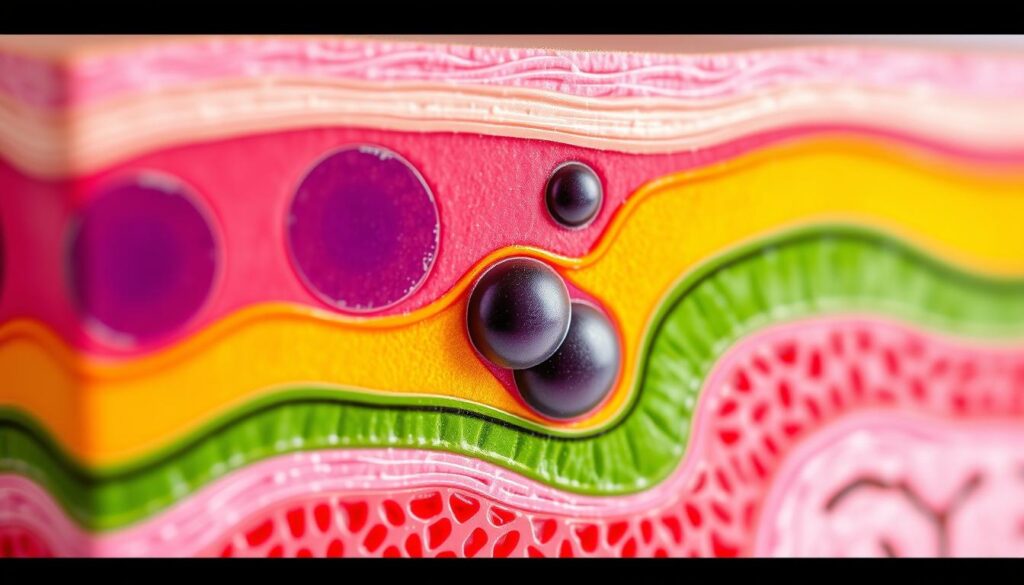
What Causes Hyperpigmentation?
Hyperpigmentation occurs when there’s an overproduction of melanin, the pigment responsible for Skin color. Sun exposure is a primary cause, as UV rays stimulate melanin production, potentially leading to dark spots or uneven Skin tone. Hormonal changes, especially during pregnancy, can also trigger hyperpigmentation, resulting in conditions like melasma. Additionally, Skin injuries or inflammation can cause post-inflammatory hyperpigmentation.
Common Types of Pigmentation Issues
Pigmentation issues manifest in various forms, including freckles, age spots, and melasma. Freckles are small, flat spots that often appear on sun-exposed areas, while age spots are larger and typically occur on mature Skin. Melasma presents as larger patches, usually on the face, and is associated with hormonal changes.
Who Is Most Susceptible to Pigmentation?
Individuals with fair Skin are more prone to pigmentation issues due to lower melanin levels, making them more susceptible to UV damage. However, people with darker Skin tones can also experience hyperpigmentation, particularly post-inflammatory hyperpigmentation. Genetic factors play a significant role, and hormonal changes can affect anyone, regardless of Skin type.
The Science Behind Effective Natural Treatments
The effectiveness of natural treatments in tackling pigmentation lies in their ability to target melanin production. Natural ingredients have been shown to influence the biological processes that lead to hyperpigmentation, offering a promising avenue for treatment.
How Natural Ingredients Target Melanin Production
Natural ingredients such as turmeric, lemon, and aloe vera work by inhibiting the enzymes responsible for melanin synthesis. For instance, turmeric contains curcumin, which has been shown to reduce melanin production by inhibiting the activity of tyrosinase, a key enzyme in melanin synthesis.

The Role of Antioxidants in Fighting Pigmentation
Antioxidants play a crucial role in combating pigmentation by neutralizing free radicals that can stimulate melanin production. Ingredients rich in antioxidants, such as green tea and vitamin C, help protect the Skin from oxidative stress, thereby reducing the appearance of pigmentation.
| Antioxidant | Source | Benefit |
|---|---|---|
| Vitamin C | Citrus fruits, berries | Reduces melanin production |
| Green Tea Extract | Green tea leaves | Protects against oxidative stress |
| Curcumin | Turmeric | Inhibits tyrosinase activity |
Why Consistency Matters in Treatment
Consistency is key when it comes to natural treatments for pigmentation. Regular application of these treatments ensures that the Skin is continuously exposed to the active ingredients, leading to more effective and sustained results over time.
Powerful Kitchen Ingredients That Fight Pigmentation
Your kitchen is a treasure trove of natural ingredients that can help combat pigmentation and achieve a more even Skin tone. Many common kitchen ingredients have been found to possess properties that can help reduce the appearance of pigmentation. Let’s explore some of these ingredients and their benefits.
Lemon and Citrus Fruits
Lemon and other citrus fruits are rich in vitamin C, a powerful antioxidant that can help brighten the Skin and reduce pigmentation. The citric acid in these fruits also acts as a natural exfoliant, promoting cell turnover and helping to even out Skin tone.
Key benefits: Brightening, antioxidant, exfoliating
Turmeric and Its Brightening Properties
Turmeric contains curcumin, a compound known for its anti-inflammatory and antioxidant properties. Curcumin can help reduce melanin production, thereby lightening areas of pigmentation and promoting a more even Skin tone.
- Reduces inflammation
- Antioxidant properties
- Brightens Skin
Apple Cider Vinegar
Apple cider vinegar is known for its natural balancing properties. It can help adjust the Skin’s pH, reduce the appearance of pigmentation, and promote a clearer complexion.
Tip: Mix with water before applying to the Skin to avoid irritation.
Potato and Cucumber
Both potatoes and cucumbers have natural cooling and soothing properties. They can help reduce inflammation and lighten pigmented areas. The antioxidants in these vegetables also contribute to healthier Skin.

Papaya and Enzymes
Papaya contains an enzyme called papain, which helps exfoliate the Skin, removing dead Skin cells and promoting a brighter complexion. Regular use can help reduce the appearance of pigmentation.
Benefit: Exfoliates and brightens the Skin
By incorporating these kitchen ingredients into your skincare routine, you can naturally combat pigmentation and achieve a more even Skin tone. Consistency is key, so make sure to use these ingredients regularly for the best results.
Essential Oils and Natural Extracts for Even Skin Tone
Essential oils and natural extracts offer a promising solution for those seeking to reduce pigmentation and achieve a more even Skin tone. These natural ingredients have been used for centuries in various cultures for their beneficial properties.
Tea Tree Oil
Tea tree oil is renowned for its antimicrobial properties, which can help in reducing inflammation and preventing infections that may lead to pigmentation. Its ability to balance Skin pH and reduce scarring makes it a valuable addition to skincare routines.
Rosehip Oil
Rosehip oil is rich in antioxidants and essential fatty acids, making it an excellent moisturizer that can help regenerate Skin cells. It is particularly beneficial for reducing the appearance of scars and fine lines, contributing to a more even Skin tone.
Aloe Vera
Aloe vera is well-known for its soothing and healing properties. It contains aloin, which has been shown to reduce pigmentation by inhibiting melanin production. Regular application of aloe vera gel can lead to a more even Skin tone and reduced appearance of hyperpigmentation.
Sandalwood
Sandalwood oil has anti-inflammatory properties that can help soothe the Skin and reduce redness associated with pigmentation. Its antiseptic properties also aid in healing Skin irritations.
Licorice Extract
Licorice extract contains glabridin, which has been proven to inhibit tyrosinase activity, an enzyme involved in melanin production. This makes licorice extract effective in reducing hyperpigmentation and achieving a more even Skin tone.
By incorporating these essential oils and natural extracts into your skincare routine, you can take a significant step towards achieving a more even and radiant complexion. As with any skincare product, it’s essential to patch test and consult with a dermatologist if you have sensitive Skin.
Home Remedies for Pigmentation: 10 Proven Methods
Home remedies offer a gentle yet effective way to tackle pigmentation, utilizing ingredients easily found in most kitchens. These natural treatments can be a game-changer for those seeking a more holistic approach to Skin care.
Turmeric and Honey Mask
Turmeric, with its active ingredient curcumin, has potent anti-inflammatory and antioxidant properties that can help reduce pigmentation. Mixing turmeric with honey creates a soothing mask that can be applied once or twice a week.
Lemon Juice and Yogurt Treatment
Lemon juice is known for its natural bleaching properties, while yogurt provides moisturization. Combining these can help lighten pigmented areas without drying out the Skin.
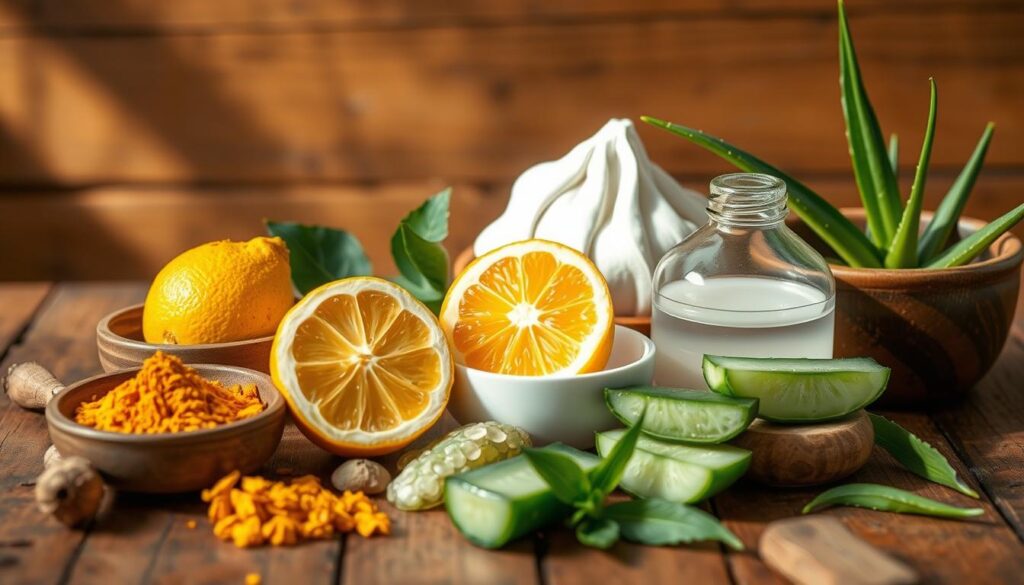
Aloe Vera Gel Overnight Application
Aloe vera is renowned for its soothing and healing properties. Applying aloe vera gel overnight can help reduce inflammation and promote even Skin tone.
Apple Cider Vinegar Toner
Apple cider vinegar acts as a natural toner, balancing the Skin’s pH and reducing the appearance of pigmentation over time.
Potato Slice Therapy
Potato slices can be used as a natural remedy to reduce pigmentation. The enzymes present in potatoes can help lighten dark spots.
Green Tea Extract Application
Green tea is rich in antioxidants, which can help protect the Skin from damage and reduce pigmentation. Applying cooled green tea extract to the Skin can be beneficial.
| Remedy | Key Ingredient | Benefits |
|---|---|---|
| Turmeric and Honey Mask | Curcumin | Reduces inflammation, antioxidant properties |
| Lemon Juice and Yogurt | Lemon Juice | Natural bleaching, moisturizes |
| Aloe Vera Gel | Aloe Vera | Soothes, promotes even Skin tone |
By incorporating these home remedies into your skincare routine, you can effectively tackle pigmentation issues and achieve a more even Skin tone. Consistency is key, so it’s essential to stick to the treatments and be patient.
DIY Face Masks for Different Types of Pigmentation
Different types of pigmentation demand different treatments, and homemade face masks can be highly effective. By tailoring your skincare routine to your specific pigmentation concerns, you can achieve a more even Skin tone and reduce the appearance of dark spots.
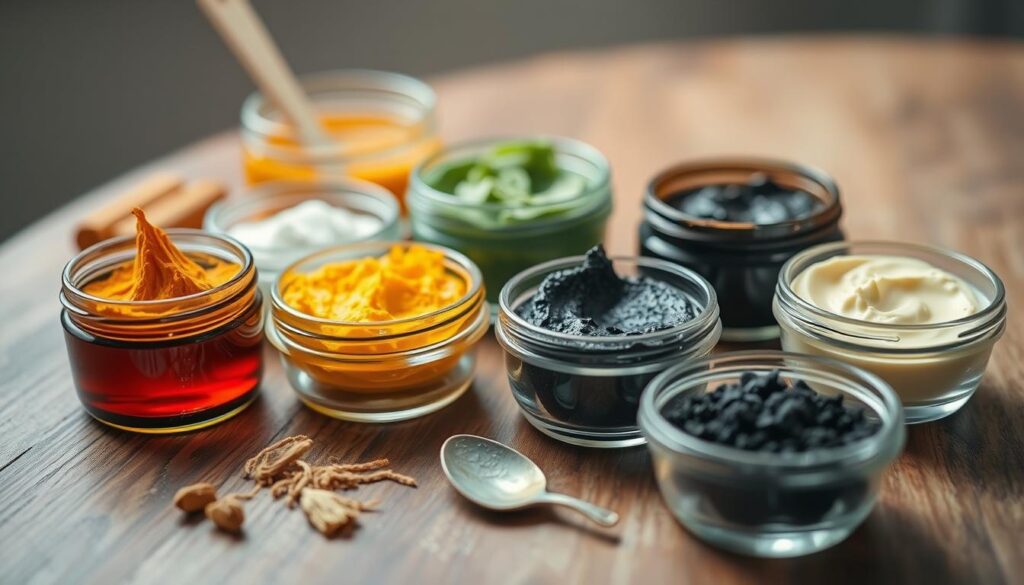
For Sun Spots and Freckles
Sun spots and freckles are often caused by prolonged sun exposure. To address these issues, try a face mask made with lemon juice and honey. Mix equal parts lemon juice and honey, apply to the affected areas, and leave on for 15-20 minutes before rinsing.
- Lemon juice contains citric acid, which helps lighten pigmentation.
- Honey provides moisturizing benefits and soothes the Skin.
For Melasma and Hormonal Pigmentation
Melasma and hormonal pigmentation can be challenging to treat. A face mask containing turmeric and aloe vera can be particularly effective. Mix 1 teaspoon of turmeric powder with 2 tablespoons of aloe vera gel and apply to the affected areas.
- Turmeric’s active ingredient, curcumin, has potent anti-inflammatory and Skin-brightening properties.
- Aloe vera helps calm the Skin and reduce inflammation.
For Post-Inflammatory Hyperpigmentation
Post-inflammatory hyperpigmentation (PIH) occurs after Skin inflammation or injury. To reduce PIH, use a face mask made with cucumber and green tea extract. Grate a cucumber and mix it with a few drops of green tea extract, then apply to the affected areas.
- Cucumber cools and soothes the Skin, reducing inflammation.
- Green tea extract is rich in antioxidants, which help promote Skin healing.
For Age Spots
Age spots are a common concern for many individuals. To address these, try a face mask containing papaya and almond oil. Mash ripe papaya and mix it with a few drops of almond oil, then apply to the affected areas.
- Papaya contains papain, an enzyme that helps exfoliate and brighten the Skin.
- Almond oil nourishes and moisturizes the Skin, reducing the appearance of fine lines.
By incorporating these DIY face masks into your skincare routine, you can effectively target different types of pigmentation and achieve a more radiant, even-toned complexion.
Realistic Timeframes: When to Expect Results
When it comes to tackling pigmentation, knowing what to expect and when is key to a successful treatment. The timeframe for seeing improvements can vary significantly from person to person, depending on several factors including the type and severity of pigmentation, Skin type, and the consistency of treatment application.
Short-Term Improvements (1-4 Weeks)
In the initial stages of treatment, typically within 1-4 weeks, you may start to notice subtle improvements in your Skin. These can include a slight brightening of the Skin tone and a reduction in the appearance of minor pigmentation issues. Consistency is key during this period to lay the groundwork for further improvements.
Medium-Term Changes (1-3 Months)
As you progress into the 1-3 month range, you can expect more noticeable changes. The Skin should start to look more even-toned, and pigmentation issues may become less pronounced. It’s essential to continue with your treatment regimen without interruption to achieve these medium-term results.
Long-Term Pigmentation Management
For significant and lasting results, long-term commitment to your pigmentation treatment is necessary. This can involve ongoing application of treatments, lifestyle adjustments, and sun protection strategies. Patience and persistence are crucial as your Skin continues to improve over time.
Factors That Affect Your Results
Several factors can influence the effectiveness and timeframe of your pigmentation treatment, including your Skin type, the severity of pigmentation, and how consistently you apply treatments. 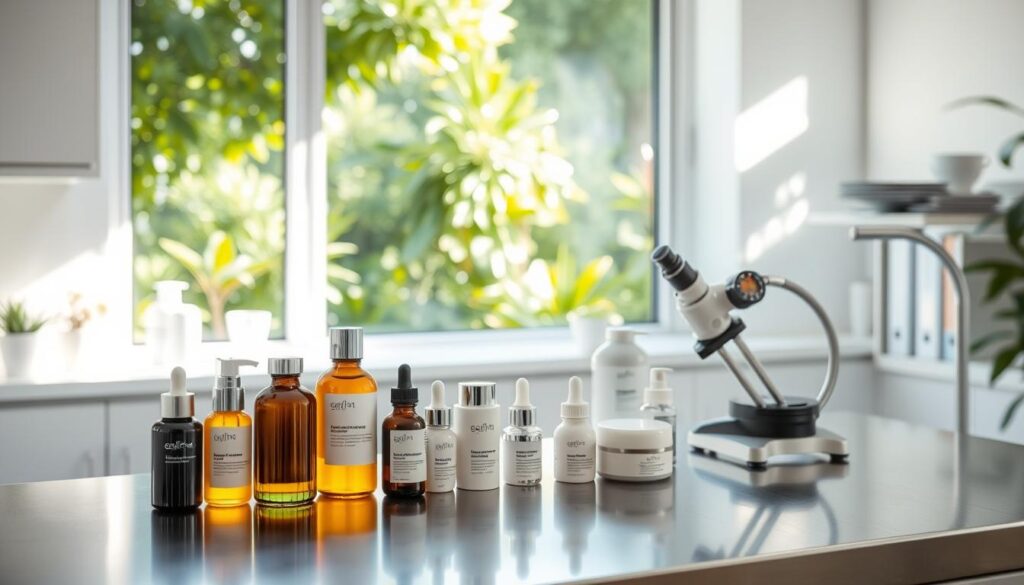
- Skin Type: Different Skin types respond at varying rates to treatment.
- Severity of Pigmentation: More severe cases may require longer treatment durations.
- Consistency of Application: Regular and consistent application of treatments yields better results.
Lifestyle Changes That Complement Pigmentation Treatment
To achieve the best results in tackling pigmentation, it’s essential to combine treatments with healthy lifestyle habits. While home remedies and medical treatments are crucial, certain lifestyle adjustments can significantly enhance their effectiveness.
Sun Protection Strategies
One of the most critical lifestyle changes is adopting robust sun protection strategies. Using a broad-spectrum sunscreen with at least SPF 30 daily, wearing protective clothing, and avoiding peak sun hours can prevent further pigmentation.
- Apply sunscreen 15 minutes before going outdoors.
- Reapply every two hours or immediately after swimming or sweating.
- Use lip balm with SPF to protect your lips.
Dietary Adjustments for Healthier Skin
A diet rich in antioxidants, vitamins, and minerals can promote healthier Skin. Include foods like berries, leafy greens, and fatty fish in your diet to help combat pigmentation.
Berries are rich in antioxidants that help reduce oxidative stress.
Hydration and Its Impact on Pigmentation
Staying hydrated is vital for Skin health. Drinking plenty of water helps flush out toxins and keep your Skin hydrated from the inside out.
Stress Management for Hormonal Balance
High stress levels can lead to hormonal imbalances, which may exacerbate pigmentation issues. Practicing stress-reducing techniques like yoga, meditation, or deep breathing exercises can help manage stress.
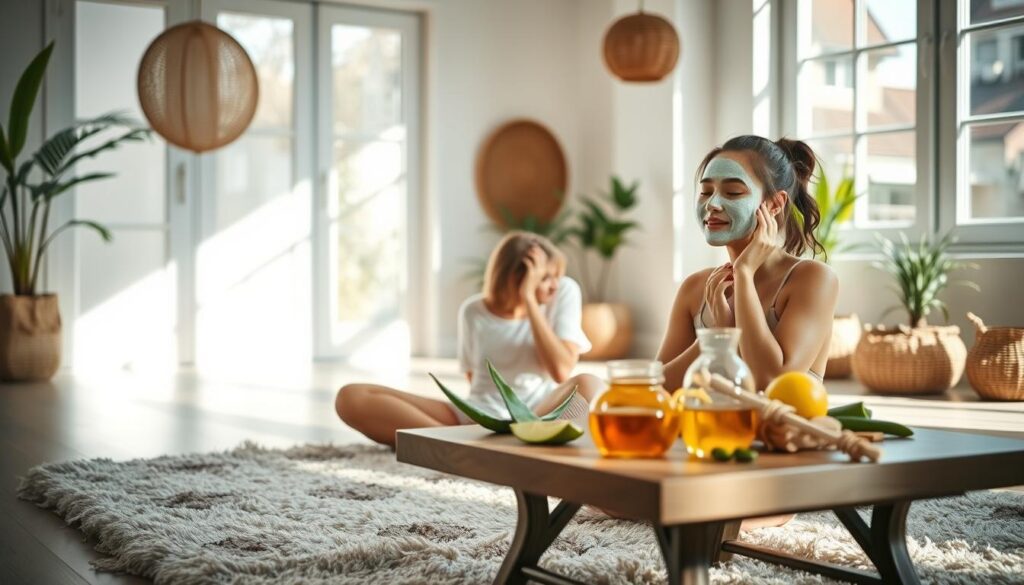
When to Consult a Dermatologist About Pigmentation
If you’re experiencing persistent or severe pigmentation issues, it’s crucial to know when to seek professional help. While home remedies can be effective for mild cases, certain situations require the expertise of a dermatologist.
Warning Signs That Home Remedies Aren’t Enough
If you’ve been using home remedies consistently for a few months without seeing any improvement, it may be time to consult a dermatologist. Signs that home remedies aren’t working include increased darkening of pigmented areas, spreading of the pigmentation, or if the pigmentation is accompanied by other symptoms like itching or pain.
Professional Treatments That Complement Home Care
Dermatologists offer a range of treatments that can complement home care, including chemical peels, microdermabrasion, and laser therapy. These treatments can help reduce pigmentation more effectively than home remedies alone. A dermatologist can recommend the best treatment based on the type and severity of your pigmentation.
Conditions That Require Medical Attention
Certain conditions, such as melasma, post-inflammatory hyperpigmentation (PIH), and Skin cancer, require medical attention. If you suspect that your pigmentation is related to an underlying medical condition, it’s essential to consult a dermatologist for proper diagnosis and treatment.
In conclusion, while home remedies can be a good starting point for addressing pigmentation, knowing when to consult a dermatologist is crucial for effective treatment. By recognizing the warning signs and understanding the professional treatments available, you can take a comprehensive approach to managing pigmentation.
Conclusion: Creating Your Personalized Pigmentation Treatment Plan
Now that you’ve explored the various home remedies and lifestyle changes to tackle pigmentation, it’s time to create a personalized treatment plan. By combining the right natural ingredients and adjusting your daily habits, you can achieve a more even and radiant complexion.
Start by identifying the home remedies for pigmentation that work best for your Skin type. Whether it’s a turmeric and honey mask or an aloe vera gel application, consistency is key. Alongside these treatments, make sure to incorporate sun protection strategies, dietary adjustments, and stress management techniques to support your Skin health.
A personalized pigmentation treatment plan is not a one-size-fits-all solution. It requires patience, dedication, and a willingness to adapt. By following the guidance outlined in this article and staying committed to your routine, you can enjoy a significant improvement in your Skin’s appearance. Begin your journey towards healthier, more radiant Skin today.





